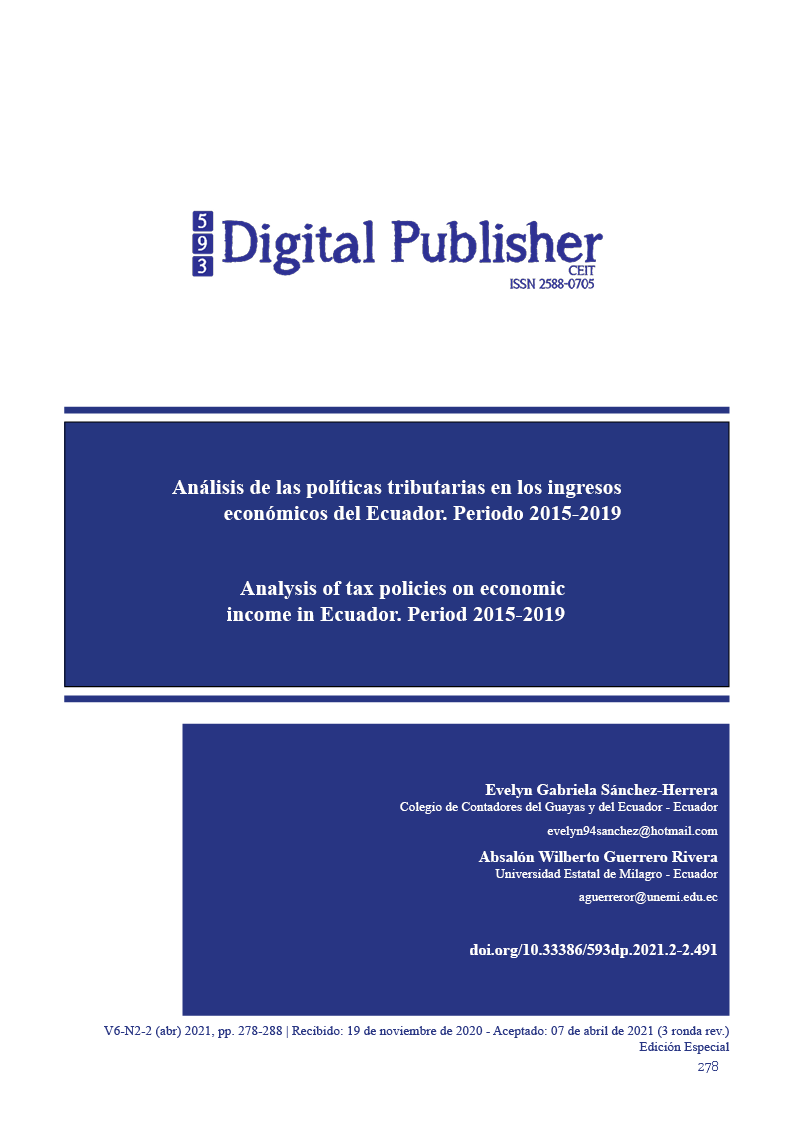Analysis of tax policies on economic income in Ecuador. Period 2015-2019
Main Article Content
Abstract
Over the years, the countries have focused all their efforts on responding to the needs of their population such as food, health, education and security, as well as proposing projects that facilitate the development of their inhabitants. Therefore, through taxes, the state can obtain economic income to finance the needs. In Ecuador, taxes have become a strength to economically sustain the activities of the state, so it is relevant to analyze the behavior of Ecuador's economic income based on tax policies that allow the generation of countless jobs in the sector public, in addition to subsidizing costs necessary for a good living and other efforts that encourage production. For this purpose, a rigorous methodology based on documentary research and methods such as: descriptive and analytical was carried out, where through the literary review the compilation of descriptive information as well as statistics about tax economic income was promoted, that Ecuador has had during the years 2015 to 2019, in which there is a decreasing collection of money from $ 13,950 million in 2015 to $ 13,479 million in 2019.
Downloads
Article Details

This work is licensed under a Creative Commons Attribution-NonCommercial-ShareAlike 4.0 International License.
1. Derechos de autor
Las obras que se publican en 593 Digital Publisher CEIT están sujetas a los siguientes términos:
1.1. 593 Digital Publisher CEIT, conserva los derechos patrimoniales (copyright) de las obras publicadas, favorece y permite la reutilización de las mismas bajo la licencia Licencia Creative Commons 4.0 de Reconocimiento-NoComercial-CompartirIgual 4.0, por lo cual se pueden copiar, usar, difundir, transmitir y exponer públicamente, siempre que:
1.1.a. Se cite la autoría y fuente original de su publicación (revista, editorial, URL).
1.1.b. No se usen para fines comerciales u onerosos.
1.1.c. Se mencione la existencia y especificaciones de esta licencia de uso.
References
Banco Central del Ecuador . (Octubre de 2014). Cálculo del Producto Interno Bruto por el Enfoque de Ingreso . Obtenido de https://www.bce.fin.ec/index.php/archivo/item/609-el-banco-central-del-ecuador-retoma-el-c%C3%A1lculo-del-producto-interno-bruto-por-el-enfoque-del-ingreso#:~:text=Esta%20informaci%C3%B3n%20es%20esencial%20para,ingreso%20del%20capital%2C%20entre%20otros.
Banco Mundial . (Octubre de 2020). Crecimiento del PIB - Ecuador . Obtenido de https://datos.bancomundial.org/indicator/NY.GDP.MKTP.KD.ZG?end=2019&locations=EC&most_recent_year_desc=false&start=1961&view=chart
Camino-Mogro , S., & Ortíz , F. (2019). La política fiscal en Ecuador: ¿es siempre procíclica? 149-168.
Carrillo Maldonado, P. (2016). El efecto de la política fiscal en expansión y recesión para Ecuador: Un modelo MSVAR. Revista Cuadernos de Economía (Universidad Nacional de Colombia), 405-439.
Kiziryan, M. (2020). Impuestos Directos. Obtenido de Economipedia: https://economipedia.com/definiciones/impuestos-directos.html
Kiziryan, M. (2020). Impuestos Indirectos. Obtenido de Economipedia: https://economipedia.com/definiciones/impuestos-indirectos.html
Maldonado , D., & Fernández , G. (2007). La sostenibilidad de la Política Fiscal: Caso de Ecuador. Revista Cuestiones Económicas , 68-125.
Ministerio de Economía y Finanzas. (2020). Ingresos - Principios. Obtenido de Ministerio de Economía y Finanzas: https://www.finanzas.gob.ec/ingresos-principios/
Morales , A. M., Chamba, L. A., Moreno , J. L., & Morales, G. V. (2020). El nuevo modelo económico establecido en el Ecuador. Revista Nueva Ciencia Visionario Digital, 95-115.
Pacheco , D. (2006). Ecuador: Ciclo económico y Política Fiscal . Cuestiones Económicas , 8-56.
Peréz Bustamante & Ponce . (20 de Febrero de 2015). Nuevas Reformas Tributarias . Obtenido de https://www.pbplaw.com/es/nuevas-reformas-tributarias/
Pizha Bermeo , E., Ayaviri , D., & Sánchez , P. (2015). Las políticas tributarias en el crecimiento económico de Ecuador, 2000-2015. Revista INNOVA Research Journal, 2, 10-29.
Quispe Fernandez , G., Arellano Cepeda , O., Rodríguez , E., Negrete Costales , O., & Vélez, K. (22 de Abril de 2019). Las Reformas Tributarias en el Ecuador. Análisis del período 1492 - 2015. Revista Espacios, 40.
Servicio de Rentas Internas . (15 de Enero de 2019). 2018: El mejor año de recaudación Tributaria. Obtenido de SRI: https://www.sri.gob.ec/web/guest/detalle-noticias?idnoticia=617&marquesina=1
Vega , F., Brito, L., Apolo, N., & Sotomayor , J. (2020). Influencia de la recaudación fiscal en el valor agregado bruto de los cantones de la provincia de El Oro (Ecuador), para el periodo 2007-2017. Revista Espacios, 41, 1-15.



